Full-Length Transcriptome Analysis of Skeletal Muscle of Jiangquan Black Pig at Different Developmental Stages
Abstract
:1. Introduction
2. Results
2.1. Histomorphologic Changes in the Longissimus Dorsi Muscle
2.2. Overview of Full-Length Transcriptome Data
2.3. Functional Annotation of Novel Transcript
2.4. Identification of LncRNA
2.5. SSR Analysis
2.6. Alternative Splicing
2.7. Functional Annotation and Enrichment Analysis of Differentially Expressed Genes
2.8. Time Series Expression Pattern Clustering
2.9. DEG Protein–Protein Interaction Analysis and Hub Gene Identification
2.10. Validation of the Results by qRT-PCR
3. Discussion
3.1. Differentially Expressed Genes STEM Cluster Analysis
3.2. Differentially Expressed Genes Analysis
3.3. Analysis of GO and KEGG Pathway
3.4. AS Events in Skeletal Muscle Developmental Process
3.5. Protein Interaction Network Analysis
4. Conclusions
5. Materials and Methods
5.1. Ethics Statement and Sample Collection
5.2. Hematoxylin and Eosin (HE) Staining
5.3. RNA Extraction and Sequencing Analysis
5.4. Identification of lncRNA
5.5. SSR Analysis
5.6. Alternative Splicing
5.7. Differential Expression Analysis and Gene Functional Annotation
5.8. Time Series Expression Pattern Clustering
5.9. Protein–Protein Interaction (PPI)
5.10. Quantitative Real-Time PCR (qRT-PCR) Validation
5.11. Statistical Analysis
Author Contributions
Funding
Institutional Review Board Statement
Informed Consent Statement
Data Availability Statement
Conflicts of Interest
References
- Xu, X.; Yu, Z.; Ai, N.; Liufu, S.; Liu, X.; Chen, B.; Li, X.; Jiang, J.; Zhang, Y.; Ma, H.; et al. Molecular Mechanism of MYL4 Regulation of Skeletal Muscle Development in Pigs. Genes 2023, 14, 1267. [Google Scholar] [CrossRef] [PubMed]
- Zhang, D.; Wu, S.; Zhang, X.; Ren, S.; Tang, Z.; Gao, F. Coordinated transcriptional and post-transcriptional epigenetic regulation during skeletal muscle development and growth in pigs. J. Anim. Sci. Biotechnol. 2022, 13, 146. [Google Scholar] [CrossRef] [PubMed]
- Yang, Y.; Fan, X.; Yan, J.; Chen, M.; Zhu, M.; Tang, Y.; Liu, S.; Tang, Z. A comprehensive epigenome atlas reveals DNA methylation regulating skeletal muscle development. Nucleic Acids Res. 2021, 49, 1313–1329. [Google Scholar] [CrossRef] [PubMed]
- Wang, Y.; Wang, J.; Hu, H.; Wang, H.; Wang, C.; Lin, H.; Zhao, X. Dynamic transcriptome profiles of postnatal porcine skeletal muscle growth and development. BMC Genom. Data 2021, 22, 32. [Google Scholar] [CrossRef] [PubMed]
- Ye, Y.; Wu, G.; Wang, H.; Duan, M.; Shang, P.; Chamba, Y. The Role of the MYL4 Gene in Porcine Muscle Development and Its Molecular Regulatory Mechanisms. Animals 2024, 14, 1370. [Google Scholar] [CrossRef]
- Qiu, Y.Q.; Yang, X.F.; Ma, X.Y.; Xiong, Y.X.; Tian, Z.M.; Fan, Q.L.; Wang, L.; Jiang, Z.Y. CIDE gene expression in adipose tissue, liver, and skeletal muscle from obese and lean pigs. J. Zhejiang Univ. Sci. B 2017, 18, 492–500. [Google Scholar] [CrossRef] [PubMed]
- Miao, Z.G.; Wang, L.J.; Xu, Z.R.; Huang, J.F.; Wang, Y.R. Developmental changes of carcass composition, meat quality and organs in the Jinhua pig and Landrace. Animal 2009, 3, 468–473. [Google Scholar] [CrossRef] [PubMed]
- Ma, H.; Jiang, J.; He, J.; Liu, H.; Han, L.; Gong, Y.; Li, B.; Yu, Z.; Tang, S.; Zhang, Y.; et al. Long-read assembly of the Chinese indigenous Ningxiang pig genome and identification of genetic variations in fat metabolism among different breeds. Mol. Ecol. Resour. 2022, 22, 1508–1520. [Google Scholar] [CrossRef]
- Shen, Y.; Mao, H.; Huang, M.; Chen, L.; Chen, J.; Cai, Z.; Wang, Y.; Xu, N. Long Noncoding RNA and mRNA Expression Profiles in the Thyroid Gland of Two Phenotypically Extreme Pig Breeds Using Ribo-Zero RNA Sequencing. Genes 2016, 7, 34. [Google Scholar] [CrossRef]
- Fu, Y.; Shang, P.; Zhang, B.; Tian, X.; Nie, R.; Zhang, R.; Zhang, H. Function of the Porcine TRPC1 Gene in Myogenesis and Muscle Growth. Cells 2021, 10, 147. [Google Scholar] [CrossRef]
- Deamer, D.; Akeson, M.; Branton, D. Three decades of nanopore sequencing. Nat. Biotechnol. 2016, 34, 518–524. [Google Scholar] [CrossRef] [PubMed]
- Hoa, V.B.; Seong, P.N.; Cho, S.H.; Kang, S.M.; Kim, Y.S.; Moon, S.S.; Choi, Y.M.; Kim, J.H.; Seol, K.H. Quality characteristics and flavor compounds of pork meat as a function of carcass quality grade. Asian Australas. J. Anim. Sci. 2019, 32, 1448–1457. [Google Scholar] [CrossRef] [PubMed]
- Endo, T. Molecular mechanisms of skeletal muscle development, regeneration, and osteogenic conversion. Bone 2015, 80, 2–13. [Google Scholar] [CrossRef] [PubMed]
- Battistelli, C.; Garbo, S.; Maione, R. MyoD-Induced Trans-Differentiation: A Paradigm for Dissecting the Molecular Mechanisms of Cell Commitment, Differentiation and Reprogramming. Cells 2022, 11, 3435. [Google Scholar] [CrossRef] [PubMed]
- Wang, R.; Chen, F.; Chen, Q.; Wan, X.; Shi, M.; Chen, A.K.; Ma, Z.; Li, G.; Wang, M.; Ying, Y.; et al. MyoD is a 3D genome structure organizer for muscle cell identity. Nat. Commun. 2022, 13, 205. [Google Scholar] [CrossRef] [PubMed]
- Piasecka, A.; Sekrecki, M.; Szczesniak, M.W.; Sobczak, K. MEF2C shapes the microtranscriptome during differentiation of skeletal muscles. Sci. Rep. 2021, 11, 3476. [Google Scholar] [CrossRef] [PubMed]
- Mai, M.; Jin, L.; Tian, S.; Liu, R.; Huang, W.; Tang, Q.; Ma, J.; Jiang, A.; Wang, X.; Hu, Y.; et al. Deciphering the microRNA transcriptome of skeletal muscle during porcine development. PeerJ 2016, 4, e1504. [Google Scholar] [CrossRef] [PubMed]
- Zhao, X.; Huang, Z.; Liu, X.; Chen, Y.; Gong, W.; Yu, K.; Qin, L.; Chen, H.; Mo, D. The switch role of the Tmod4 in the regulation of balanced development between myogenesis and adipogenesis. Gene 2013, 532, 263–271. [Google Scholar] [CrossRef] [PubMed]
- Zhang, J.; Sheng, H.; Pan, C.; Wang, S.; Yang, M.; Hu, C.; Wei, D.; Wang, Y.; Ma, Y. Identification of key genes in bovine muscle development by co-expression analysis. PeerJ 2023, 11, e15093. [Google Scholar] [CrossRef]
- Gokhin, D.S.; Ochala, J.; Domenighetti, A.A.; Fowler, V.M. Tropomodulin 1 directly controls thin filament length in both wild-type and tropomodulin 4-deficient skeletal muscle. Development 2015, 142, 4351–4362. [Google Scholar] [CrossRef]
- Diekstra, M.; Swen, J.J.; van der Zanden, L.; Vermeulen, S.H.; Boven, E.; Mathijssen, R.; Fukunaga, K.; Mushiroda, T.; Hongo, F.; Oosterwijk, E.; et al. Genome-Wide Meta-Analysis Identifies Variants in DSCAM and PDLIM3 That Correlate with Efficacy Outcomes in Metastatic Renal Cell Carcinoma Patients Treated with Sunitinib. Cancers 2022, 14, 2838. [Google Scholar] [CrossRef] [PubMed]
- Yin, H.; Zhao, J.; He, H.; Chen, Y.; Wang, Y.; Li, D.; Zhu, Q. Gga-miR-3525 Targets PDLIM3 through the MAPK Signaling Pathway to Regulate the Proliferation and Differentiation of Skeletal Muscle Satellite Cells. Int. J. Mol. Sci. 2020, 21, 5573. [Google Scholar] [CrossRef] [PubMed]
- Te, V.A.; Ott, E.B.; Marques, I.J.; Bagowski, C.P. Gene expression patterns of the ALP family during zebrafish development. Gene Expr. Patterns 2007, 7, 297–305. [Google Scholar] [CrossRef] [PubMed]
- Xue, K.; Wang, Y.; Hou, Y.; Wang, Y.; Zhong, T.; Li, L.; Zhang, H.; Wang, L. Molecular characterization and expression patterns of the actinin-associated LIM protein (ALP) subfamily genes in porcine skeletal muscle. Gene 2014, 539, 111–116. [Google Scholar] [CrossRef] [PubMed]
- Zhang, K.Y.; Zhang, G.J.; Duan, H.Q.; Li, Q.X.; Huang, K.; Xu, L.Q.; Yang, H.; Luo, Y.B. CASQ1-related myopathy: The first report from China and the literature review. Clin. Case Rep. 2022, 10, e6689. [Google Scholar] [CrossRef] [PubMed]
- Woo, J.S.; Jeong, S.Y.; Park, J.H.; Choi, J.H.; Lee, E.H. Calsequestrin: A well-known but curious protein in skeletal muscle. Exp. Mol. Med. 2020, 52, 1908–1925. [Google Scholar] [CrossRef] [PubMed]
- Luo, B.; Ye, M.S.; Xu, H.Y.; Ma, E.Y.; Ye, F.; Cui, C.; Zhu, Q.; Zhao, X.L.; Yin, H.D.; Li, D.Y.; et al. Expression analysis, single-nucleotide polymorphisms of the Myoz1 gene and their association with carcase and meat quality traits in chickens. Ital. J. Anim. Sci. 2018, 17, 907–915. [Google Scholar] [CrossRef]
- Liu, Y.; Zhou, K.; Li, X.Y.; Zhao, S.H.; Cao, J.H. Expression Profiling of MYOZ1 Gene in Porcine Tissue and C2C12 Cells. J. Anim. Vet. Adv. 2011, 10, 1917–1921. [Google Scholar] [CrossRef]
- Zhou, T.; Wu, Y.; Bi, Y.; Bai, H.; Jiang, Y.; Chen, G.; Chang, G.; Wang, Z. MYOZ1 Gene Promotes Muscle Growth and Development in Meat Ducks. Genes 2022, 13, 1574. [Google Scholar] [CrossRef]
- Yoshimoto, Y.; Ikemoto-Uezumi, M.; Hitachi, K.; Fukada, S.I.; Uezumi, A. Methods for Accurate Assessment of Myofiber Maturity During Skeletal Muscle Regeneration. Front. Cell. Dev. Biol. 2020, 8, 267. [Google Scholar] [CrossRef]
- Hu, Q.; Zhu, L.; Li, Y.; Zhou, J.; Xu, J. ACTA1 is inhibited by PAX3-FOXO1 through RhoA-MKL1-SRF signaling pathway and impairs cell proliferation, migration and tumor growth in Alveolar Rhabdomyosarcoma. Cell Biosci. 2021, 11, 25. [Google Scholar] [CrossRef] [PubMed]
- Ma, T.; Liu, Y.; Wei, X.; Xue, Q.; Zheng, Z.; Xu, X. Polymorphism of coupled indels in porcine TNNC2 alters its transcript splicing and is associated with meat quality traits. Anim. Genet. 2022, 53, 175–182. [Google Scholar] [CrossRef] [PubMed]
- Xie, S.; Liu, Q.; Fu, C.; Chen, Y.; Li, M.; Tian, C.; Li, J.; Han, M.; Li, C. Molecular Regulation of Porcine Skeletal Muscle Development: Insights from Research on CDC23 Expression and Function. Int. J. Mol. Sci. 2024, 25, 3664. [Google Scholar] [CrossRef] [PubMed]
- Wolfson, R.L.; Chantranupong, L.; Saxton, R.A.; Shen, K.; Scaria, S.M.; Cantor, J.R.; Sabatini, D.M. Sestrin2 is a leucine sensor for the mTORC1 pathway. Science 2016, 351, 43–48. [Google Scholar] [CrossRef] [PubMed]
- Hernandez-Garcia, A.D.; Columbus, D.A.; Manjarin, R.; Nguyen, H.V.; Suryawan, A.; Orellana, R.A.; Davis, T.A. Leucine supplementation stimulates protein synthesis and reduces degradation signal activation in muscle of newborn pigs during acute endotoxemia. Am. J. Physiol.-Endocrinol. Metab. 2016, 311, E791–E801. [Google Scholar] [CrossRef] [PubMed]
- Xu, M.; Liu, X.; Bao, P.; Wang, Y.; Zhu, X.; Liu, Y.; Ni, X.; Lu, J. Skeletal Muscle CSE Deficiency Leads to Insulin Resistance in Mice. Antioxidants 2022, 11, 2216. [Google Scholar] [CrossRef] [PubMed]
- Hu, Z.; Cao, J.; Zhang, J.; Ge, L.; Zhang, H.; Liu, X. Skeletal Muscle Transcriptome Analysis of Hanzhong Ma Duck at Different Growth Stages Using RNA-Seq. Biomolecules 2021, 11, 315. [Google Scholar] [CrossRef]
- Bowler, E.; Oltean, S. Alternative Splicing in Angiogenesis. Int. J. Mol. Sci. 2019, 20, 2067. [Google Scholar] [CrossRef] [PubMed]
- Singh, R.K.; Kolonin, A.M.; Fiorotto, M.L.; Cooper, T.A. Rbfox-Splicing Factors Maintain Skeletal Muscle Mass by Regulating Calpain3 and Proteostasis. Cell Rep. 2018, 24, 197–208. [Google Scholar] [CrossRef]
- Sun, Y.; Xu, H.; Li, J.; Peng, M.; Jia, Z.; Kong, L.; Zhang, X.; Shao, S.; Zhang, W.; Wang, W. Genome-wide survey identifies TNNI2 as a target of KLF7 that inhibits chicken adipogenesis via downregulating FABP4. Biochim. Biophys. Acta-Gene Regul. Mech. 2023, 1866, 194899. [Google Scholar] [CrossRef]
- De Coster, W.; D’Hert, S.; Schultz, D.T.; Cruts, M.; Van Broeckhoven, C. NanoPack: Visualizing and processing long-read sequencing data. Bioinformatics 2018, 34, 2666–2669. [Google Scholar] [CrossRef] [PubMed]
- Li, H. Minimap2: Pairwise alignment for nucleotide sequences. Bioinformatics 2018, 34, 3094–3100. [Google Scholar] [CrossRef]
- Sun, L.; Luo, H.; Bu, D.; Zhao, G.; Yu, K.; Zhang, C.; Liu, Y.; Chen, R.; Zhao, Y. Utilizing sequence intrinsic composition to classify protein-coding and long non-coding transcripts. Nucleic Acids Res. 2013, 41, e166. [Google Scholar] [CrossRef]
- Kong, L.; Zhang, Y.; Ye, Z.Q.; Liu, X.Q.; Zhao, S.Q.; Wei, L.; Gao, G. CPC: Assess the protein-coding potential of transcripts using sequence features and support vector machine. Nucleic Acids Res. 2007, 35, W345–W349. [Google Scholar] [CrossRef] [PubMed]
- Finn, R.D.; Bateman, A.; Clements, J.; Coggill, P.; Eberhardt, R.Y.; Eddy, S.R.; Heger, A.; Hetherington, K.; Holm, L.; Mistry, J.; et al. Pfam: The protein families database. Nucleic Acids Res. 2014, 42, D222–D230. [Google Scholar] [CrossRef]
- Beier, S.; Thiel, T.; Munch, T.; Scholz, U.; Mascher, M. MISA-web: A web server for microsatellite prediction. Bioinformatics 2017, 33, 2583–2585. [Google Scholar] [CrossRef]
- Trincado, J.L.; Entizne, J.C.; Hysenaj, G.; Singh, B.; Skalic, M.; Elliott, D.J.; Eyras, E. SUPPA2: Fast, accurate, and uncertainty-aware differential splicing analysis across multiple conditions. Genome Biol. 2018, 19, 40. [Google Scholar] [CrossRef] [PubMed]
- Love, M.I.; Huber, W.; Anders, S. Moderated estimation of fold change and dispersion for RNA-seq data with DESeq2. Genome Biol. 2014, 15, 550. [Google Scholar] [CrossRef]
- Ernst, J.; Bar-Joseph, Z. STEM: A tool for the analysis of short time series gene expression data. BMC Bioinform. 2006, 7, 191. [Google Scholar] [CrossRef]
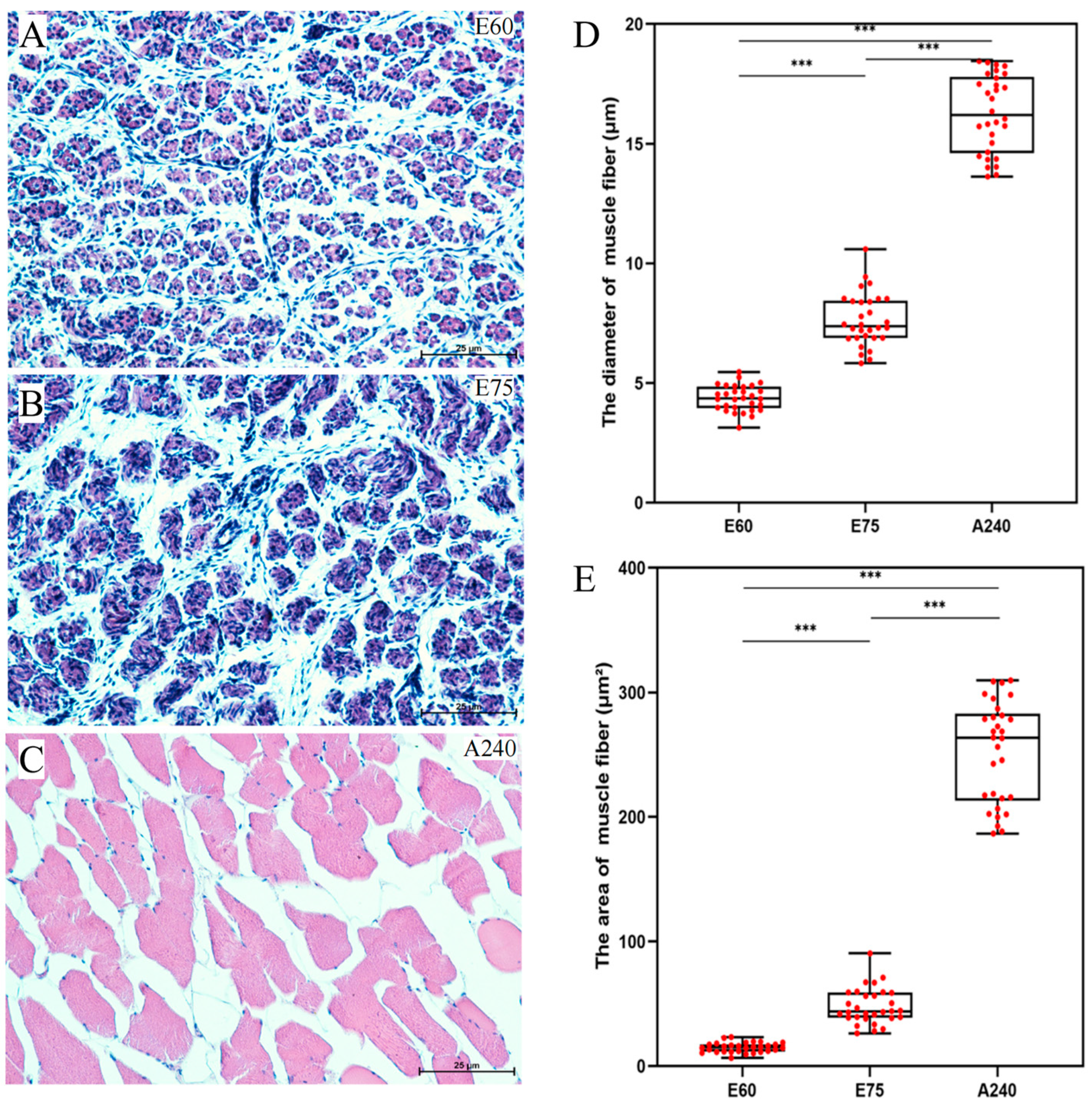

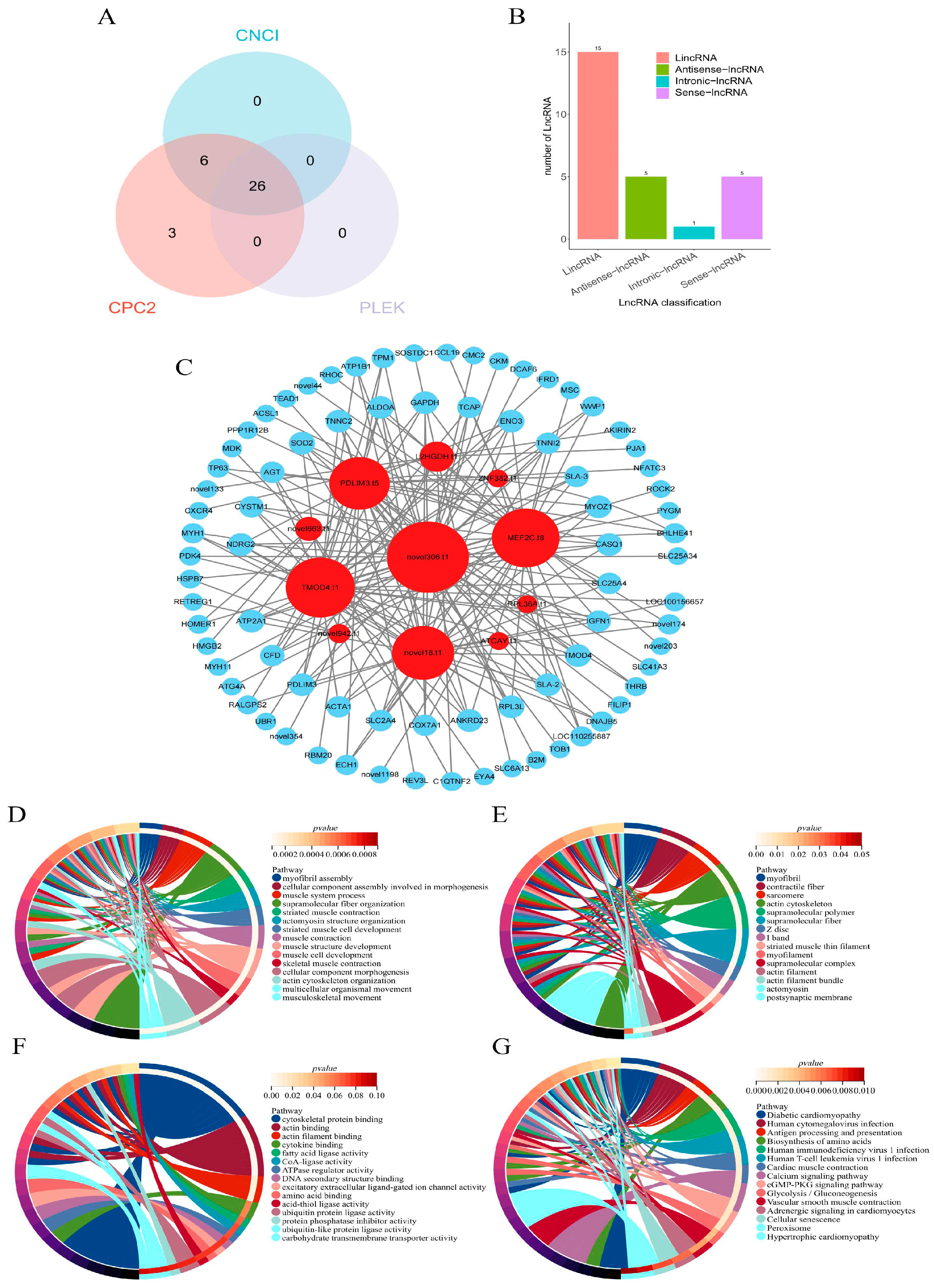
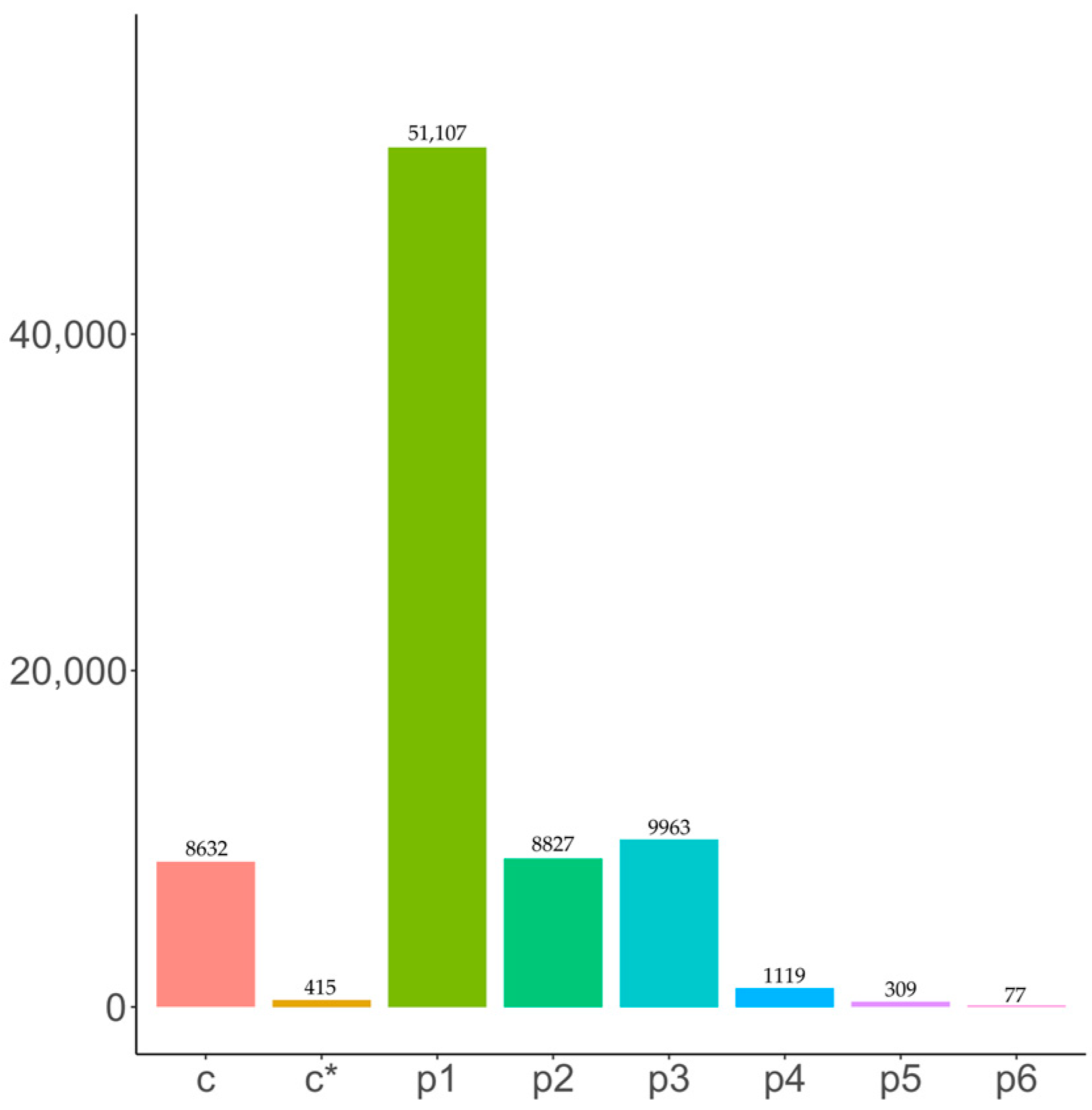
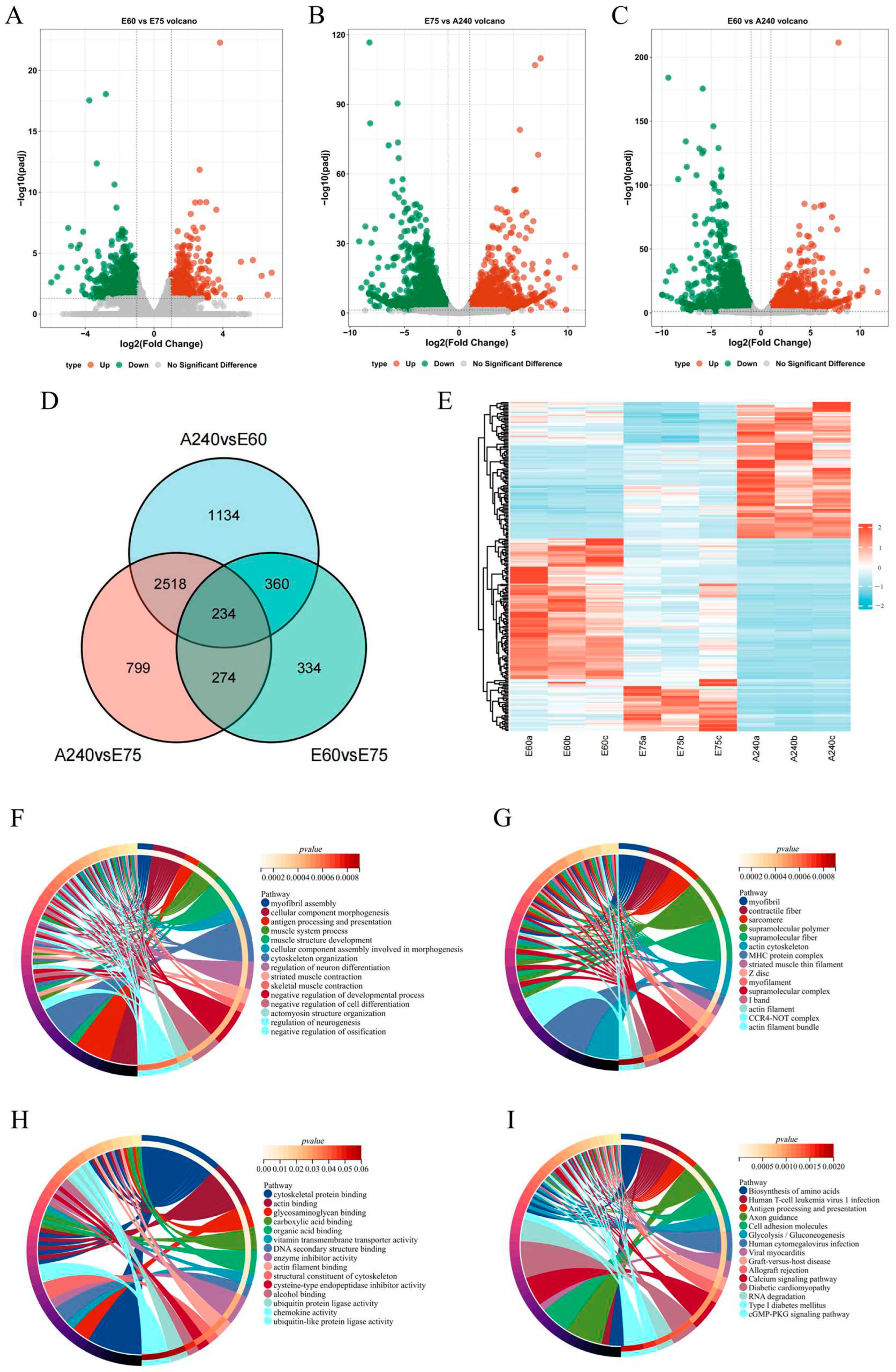

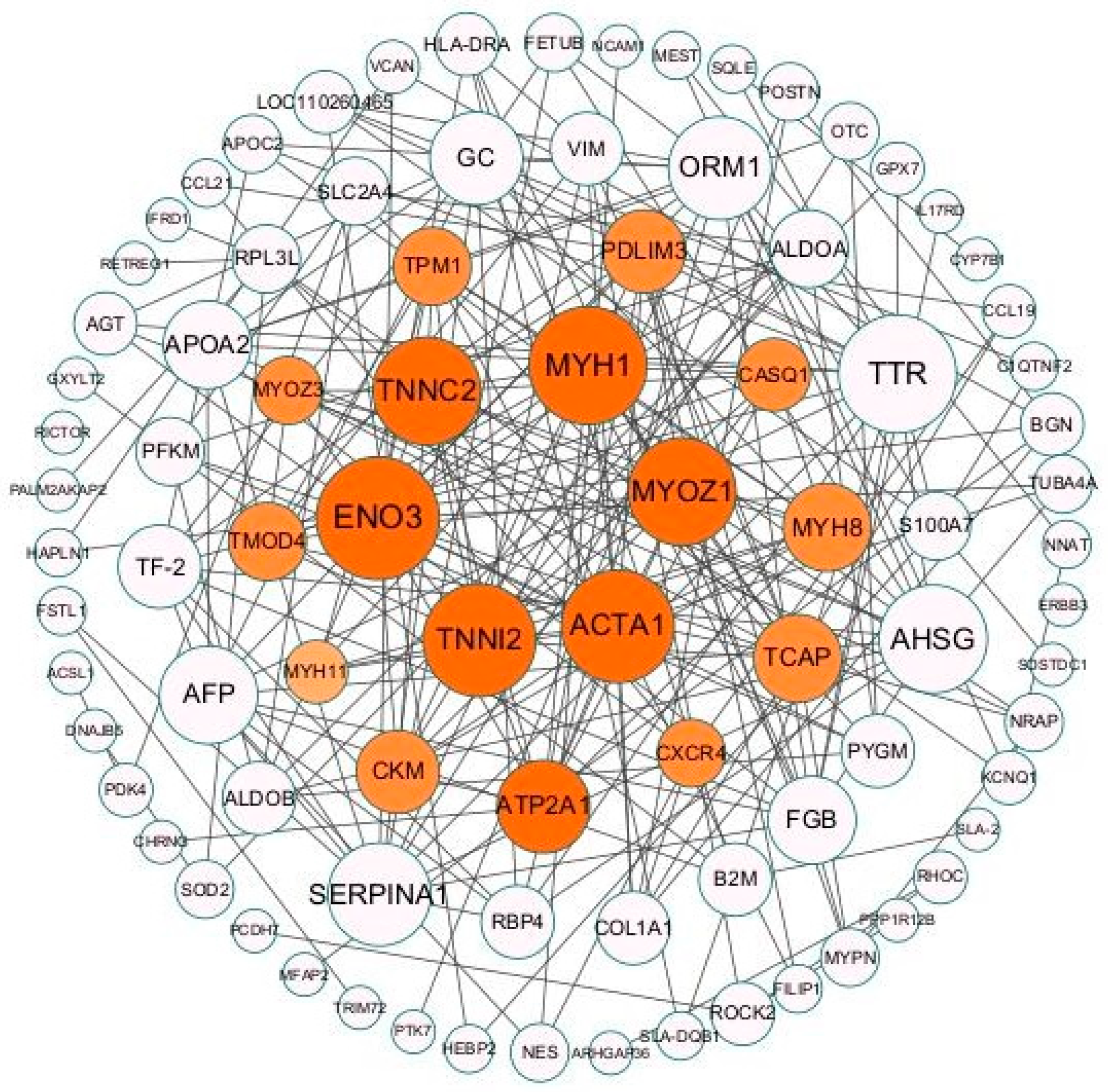
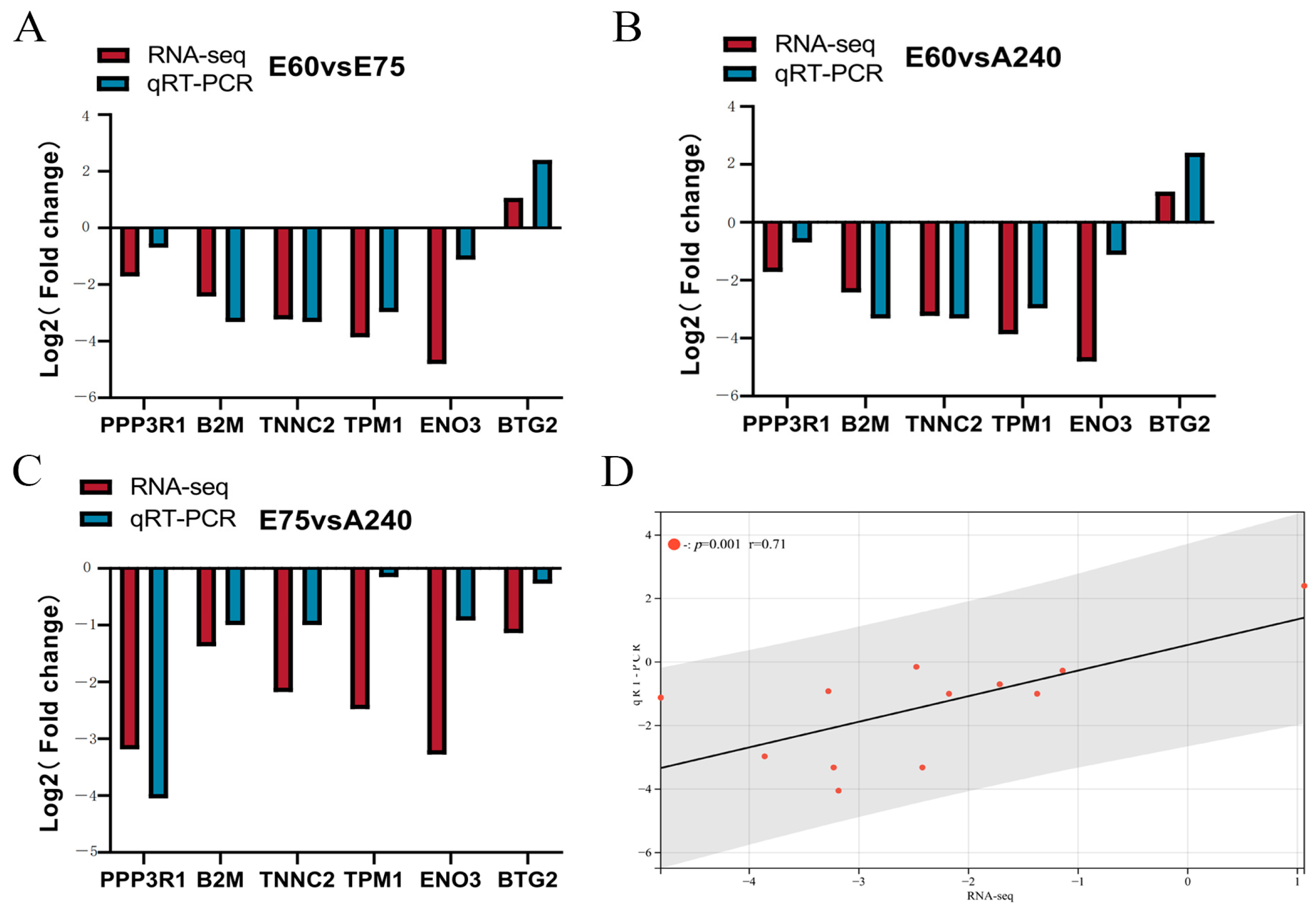
| Sample Name | Number of Clean Reads | Number of Full-Length Reads | Full-Length Percentage (FL%) | Mapped Reads | Mapped Rates % |
|---|---|---|---|---|---|
| E60a | 6,528,793 | 5,317,523 | 81.45 | 4,847,341 | 91.16 |
| E60b | 5,829,456 | 4,676,769 | 80.23 | 4,317,419 | 92.32 |
| E60c | 5,723,474 | 4,637,041 | 81.02 | 4,326,748 | 93.31 |
| E75a | 5,477,552 | 4,471,950 | 81.64 | 4,212,440 | 94.2 |
| E75b | 5,606,283 | 4,567,562 | 81.44 | 4,256,781 | 93.2 |
| E75c | 5,820,493 | 4,734,003 | 81.33 | 4,369,074 | 92.29 |
| A240a | 5,569,209 | 4,527,703 | 81.3 | 4,265,383 | 94.21 |
| A240b | 6,456,405 | 5,316,953 | 82.35 | 4,915,944 | 92.46 |
| A240c | 5,724,512 | 4,685,954 | 81.86 | 4,398,165 | 93.86 |
| Item | Count | Percentage (%) |
|---|---|---|
| All | 9374 | 100.00 |
| Annotation | 1192 | 12.72 |
| KEGG | 190 | 2.03 |
| Pathway | 189 | 2.02 |
| Nr | 694 | 7.40 |
| Uniprot | 1175 | 12.53 |
| GO | 241 | 2.57 |
| KOG | 22 | 0.23 |
| Pfam | 252 | 2.69 |
| TF | 89 | 0.95 |
| Item | Number |
|---|---|
| Total length of sequence examined (bp) | 275,294,913 |
| Total number of SSR | 91,376 |
| Total length of SSR | 138,122 |
| Relative abundance (SSR/Mb) | 331.92 |
| Relative density (bp/Mb) | 501.72 |
| Number of SSR containing sequences | 36,601 |
| Number of sequences containing more than 1 SSR | 19,805 |
| Number of SSRs present in compound formation | 8632 |
| Types of Alternative Splicing | Differential Variable Splicing Quantity | Differential Variable Splicing Ratio (%) |
|---|---|---|
| Exon skipping (SE) | 6 | 50 |
| Alternative last exon (AL) | 3 | 25 |
| Alternative first exon (AF) | 1 | 8.33 |
| Alternative 5′ splice site (A5) | 1 | 8.33 |
| Alternative 3′ splice site (A3) | 1 | 8.33 |
| Genes | Sequence (5′-3′) |
|---|---|
| PPP3R1 | F: TGAGTTACAACAAAATCCC R: ACCATCATCTTCAACACCT |
| TNNC2 | F: GCCAGACACCCACCAAAGA R: GAAGATGCGGAAGCACTCA |
| ENO3 | F: GGTCCCACTCTACCGTCAC R: CCAGGGCTTCATTGTTCTC |
| B2M | F: TCAGGTTTACTCACGCCAC R: ATCTTCTCCCCGTTTTTCA |
| BTG2 | F: AGCACTACAAACACCACTG R: GATGCGATAGGACACTTCA |
| TPM1 | F: TGAGTTACAACAAAATCCC R: ACCATCATCTTCAACACCT |
| GADPH | F: ACAGTCAAGGCGGAGAACG R: CGGCAGAAGGGGCAGAGAT |
Disclaimer/Publisher’s Note: The statements, opinions and data contained in all publications are solely those of the individual author(s) and contributor(s) and not of MDPI and/or the editor(s). MDPI and/or the editor(s) disclaim responsibility for any injury to people or property resulting from any ideas, methods, instructions or products referred to in the content. |
© 2024 by the authors. Licensee MDPI, Basel, Switzerland. This article is an open access article distributed under the terms and conditions of the Creative Commons Attribution (CC BY) license (https://creativecommons.org/licenses/by/4.0/).
Share and Cite
Song, Q.; Li, J.; Li, S.; Cao, H.; Jin, X.; Zeng, Y.; Chen, W. Full-Length Transcriptome Analysis of Skeletal Muscle of Jiangquan Black Pig at Different Developmental Stages. Int. J. Mol. Sci. 2024, 25, 6095. https://doi.org/10.3390/ijms25116095
Song Q, Li J, Li S, Cao H, Jin X, Zeng Y, Chen W. Full-Length Transcriptome Analysis of Skeletal Muscle of Jiangquan Black Pig at Different Developmental Stages. International Journal of Molecular Sciences. 2024; 25(11):6095. https://doi.org/10.3390/ijms25116095
Chicago/Turabian StyleSong, Qi, Jinbao Li, Shiyin Li, Hongzhen Cao, Xinlin Jin, Yongqing Zeng, and Wei Chen. 2024. "Full-Length Transcriptome Analysis of Skeletal Muscle of Jiangquan Black Pig at Different Developmental Stages" International Journal of Molecular Sciences 25, no. 11: 6095. https://doi.org/10.3390/ijms25116095






